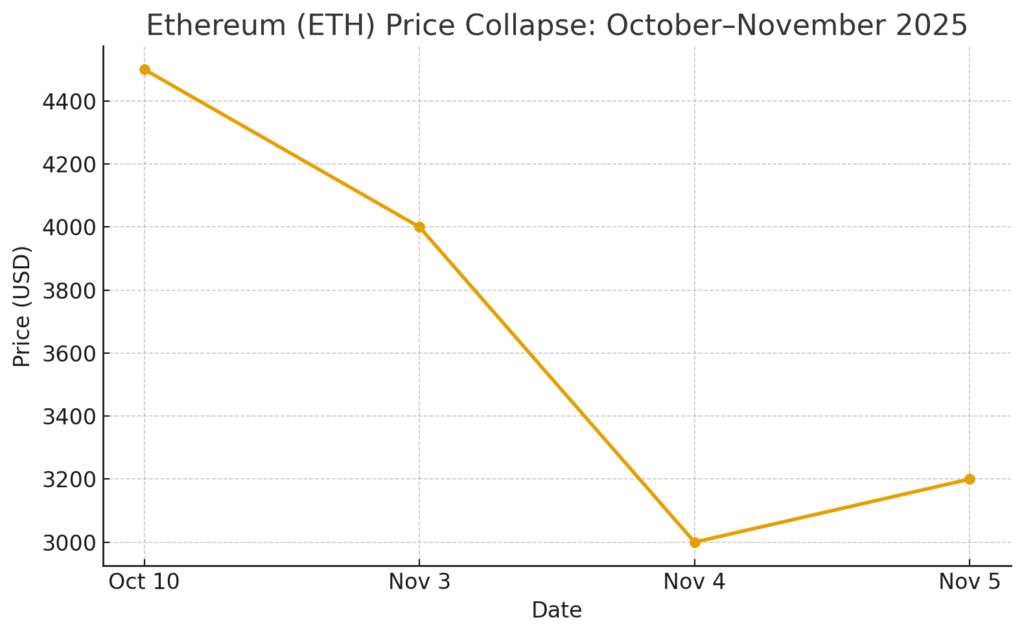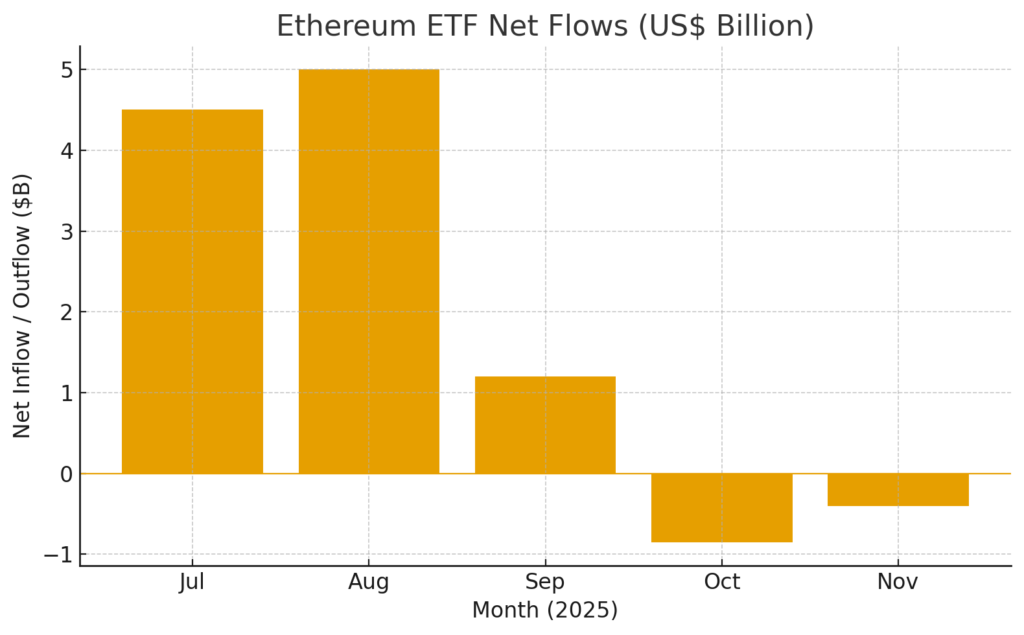
Key Points :
- Ethereum (ETH) dropped over 20% in just two days, sparking approximately $1 billion of liquidations in leveraged derivatives markets.
- The bulk of liquidated positions were longs, indicating heavily crowded bullish bets that got wiped out.
- Demand for ETH from institutional treasuries (notably BitMine) has essentially dried up, and retail/ETF interest is also waning.
- Derivatives-markets data show cautious sentiment: open interest remains low, implied volatility elevated, and funding/futures metrics point to risk aversion.
- For blockchain practitioners and new asset seekers: this episode underscores the importance of hedging, risk management, and fundamentals (on-chain metrics) rather than sheer momentum.
1. ETH’s Sharp Drop & Derivatives Fallout

In early November 2025, Ethereum fell more than 20% over a two-day span — a collapse comparable in magnitude to the flash crash of 10 October. According to market data, the ETH price slipped from just under US $4,000 to near the US $3,000 level, marking the lowest price since mid-July. As a result, the derivatives market experienced a cascade of liquidations.
Data from CoinGlass show that roughly US $970 million (approx. ¥150 billion when converted at ¥153/US$) of leveraged ETH positions were liquidated, the majority of which were long trades expecting price rises that failed to materialize. The plunge accelerated as critical support levels were breached one after another.
In short: a severe technical breakdown in a major asset triggered a ripple across the leveraged derivatives ecosystem — a warning sign for anyone exposed to new crypto-assets or building blockchains with embedded financial layers.
2. What Caused the Decline?

Several intertwining factors contributed to the sharp drop:
Institutional & Treasury Demand Exhaustion
The analysis from 10x Research, notably from Markus Thielen, indicates that major ETH-treasury accumulation by BitMine appears to have run its course. BitMine reportedly holds ~3.4 million ETH with an estimated acquisition cost of ~US $3,909 (≈ ¥600 k) per ETH, translating to an unrealised loss of around US $2 billion under the current price. According to Thielen, “the real concern is: now that BitMine’s fire-power is exhausted, who steps in to buy ETH at these levels?”
ETF & Retail Demand Weakness
In July–August, ETH ETF inflows peaked near US $9.5 billion, but since then, inflows have virtually dried up. In October’s market stress, only about US $850 million flowed out of ETH ETFs — but the lack of fresh demand at current levels means sellers may dominate. Simultaneously, Google-search interest in “Ethereum” has fallen to about 13% of its peak, underscoring a significant drop in retail interest.
Technical Breakdown & Leverage Unwinding
On the derivatives front, the large number of long positions formed a crowded trade. Once ETH failed to hold support (and broader market risk-off arrived), the unwind was rapid. The result: liquidations triggered more selling, which in turn led to more price declines — a classic deleveraging spiral.
3. Broader Derivatives Market Sentiment & Risk Dynamics

Beyond ETH itself, the recent price action reveals structural changes in how crypto traders approach leverage and hedging.
Liquidation Scale & Concentration
Across the market, about US $1.36 billion of positions were liquidated in a 24-hour window. ETH accounted for roughly US $355 million of that, with Bitcoin at ~US $411 million. Long positions dominated the wipe-out.
Open Interest & Funding Rates
According to the Bybit × Block Scholes report, after the historic ~US $19 billion liquidation event of 10 October, open interest in perpetuals languishes below US $10 billion. Funding rates turned negative for some assets and remain muted, suggesting traders are in a “wait” mode rather than aggressive accumulation.
Elevated Hedging Activity
Options markets reveal a different story: implied volatility remains high (ETH implied vol ~60%) while trading volumes in puts (downside protection) are elevated. This is symptomatic of participants expecting further risk rather than chasing upside.
4. Implications for New Crypto Assets & Blockchain Projects
For investors and practitioners focused on discovering “the next big thing” in crypto, the ETH debacle presents both cautionary data and actionable insights.
Risk Management Trumps All
Excessive leverage, especially when a trade becomes a consensus (e.g., “buy ETH because institutional demand is insatiable”), invites liquidation risk. Projects building financial primitives (e.g., staking derivatives, leveraged products) must embed safeguards against cascade events. Academic work on liquidation modeling in DeFi confirms that systems often underestimate tail risks.
Fundamentals Matter — On-Chain Data Guides Better
When aggregate demand dries up (institutional + retail) and risk-off dominates, momentum falters. On-chain metrics such as network activity, application revenue, treasury holdings, and token utility become more important than pure hype. In fact, some recent research shows ETH’s network has still posted all-time highs in application revenue, which could argue for accumulation on pullbacks.
Opportunity in Under-Accentuated Narratives
ETH’s sell-off occurred despite strong protocol fundamentals; this highlights mispricing risk and opportunities in overlooked areas (e.g., niche altcoins, novel layer-1s, or application-specific tokens). However, new entrants must beware—they might face similar leverage and sentiment dynamics if they scale too fast on hype alone.
Blockchain Use Cases Must Be Robust
For projects designing practical blockchain applications (including your interest in asset-backed representation vs autonomous trust tender), this moment reinforces the need for real-world usage, stable demand, strong incentives, and risk-control. When markets turn, usage and value accrue to systems with strong structural resilience.
5. What to Watch Moving Forward
Here are critical signals for participants exploring new crypto assets or building blockchain mechanisms:
- ETF/Institutional Flow Trends – Are funds net inflows or outflows? A drying institutional bid may mark a risk zone.
- Leverage Metrics & Derivatives Open Interest – Elevated long-side open interest + negative funding = vulnerability.
- On-Chain Demand vs Supply Growth – Protocols with rising active addresses, revenue, and token burn have a better cushion.
- Liquidity & Depth of Support Zones – Technical supports matter especially if large holders have large cost basis.
- Macro & Geopolitical Overhangs – Crypto remains correlated with liquidity and risk-on/risk-off tone; policy shocks still reverberate.
- Exit Velocity of Accumulators – Large treasuries offloading or corporate actors halting accumulation can sap future demand.
Conclusion
The recent ~20 % drop in ETH and the ensuing ~$1 billion derivatives liquidation form a stark reminder: even marquee protocols are vulnerable when sentiment and demand falter. For those hunting new crypto assets or developing practical blockchain use cases, this episode underscores that momentum alone cannot substitute for structural value, risk controls, and demand sustainability.
In a landscape where leverage is exaggerated, flows are fickle, and macro shocks still dominate, the winners will be those projects and assets that combine strong fundamentals, healthy demand, and robust protocols. Risk management must be baked in, liquidity ecosystems must be deep, and narratives must be backed by real utility. As the market transitions from euphoria to endurance, discipline and structure will outpace hype.

